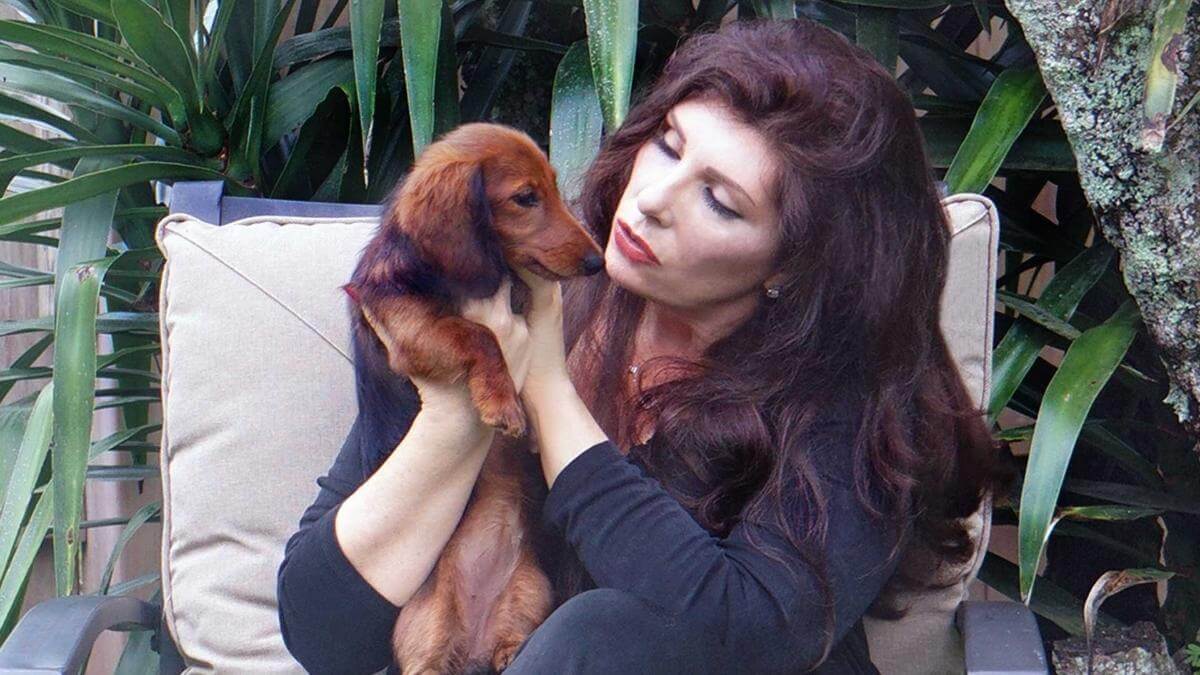
Home » Paige Horne | Royalworth Kennel

Paige Horne
1. I live in the sunny, rural heart of Central Florida, surrounded by oaks, sandhill cranes, and an ever-enthusiastic pack of Dachshunds. Even in infancy, I was drawn to animals. My grandparents raised Poodles, and their Toy Poodle, Jean Pierre, made it clear that humans crawling on all fours like dogs were not welcome. But as family legend goes, my relentless affection won him over—and I became his favorite human. That early bond sparked a lifelong passion for understanding animals; their emotions, their needs, and eventually, the science of optimal canine husbandry.
I began working with Longhaired Miniature Dachshunds in 2012, and formally established Royalworth Kennel in 2017 as part of a commitment to pursuing the noble ideals of ethical breeding. As an AKC Breeder of Merit, I’m committed to purposeful breeding, health-tested lines, active community involvement, and lifelong learning in the service of my breed. Preservation breeding isn’t a career. It’s a privileged calling.
2. Dachshunds, part of the Hound Group, are working dogs that are instantly recognizable; a long, low silhouette built for endurance and designed to follow prey into tight underground burrows or push through dense underbrush and brambles, a proud carriage, expressive eyes, and a coat that protects against brush, debris, and harsh conditions. In the longhaired variety, it also moderates temperature and adds elegance. Ideal form, as defined by the Breed Standard, supports efficient movement, durability, and function. These foundations preserve working heritage while promoting structural integrity, stable temperament, and long-term health.
Beyond physical structure, generations of selective breeding may have shaped not only the Dachshund’s form but also its neurological adaptability. Many Dachshunds seem to make their families their purpose, showing a remarkable ability to read human emotion, health cues, and the broader context around them. This sensitivity, combined with scenting ability, functional vision, and compact size, makes Dachshunds strong candidates for non-mobility service work, demonstrating aptitude for medical alerts and emotional support, while being well-suited to smaller homes. Early, structured experiences can help channel this instinctive drive and prepare them for meaningful, fulfilling roles within the family.
Form should serve function, support fulfillment, and secure the future.
3. In my experience, demand for Dachshunds remains steady, but discerning buyers are, and should be, increasingly focused on excellence; structural soundness, health guarantees, stable temperament, beauty, and early training. Those who recognize true value are willing to invest wisely and support breeders who prioritize quality and integrity. I believe that support will endure.
Our breedings are planned with great care, guided by the Breed Standard, careful attention to temperament and genetics, and a thorough evaluation of both structural and systemic health. Equally important is selecting truly compatible mates, because two wonderful dogs do not automatically produce wonderful puppies. I proceed only when a pairing meets these criteria—for myself, and to preserve exceptional lines for the future. Since I do not retain every pup, I often have prospective owners in mind who will find joy in the kind of dog that a breeding is likely to produce, making placement an extension of the same principle; thoughtful, intentional matches based on each dog’s nature and potential. This is the heart of stewardship; honest evaluation and thoughtful decisions at every step, made in service to breed advancement.
Excellence is the foundation of preservation.
4. On the science side, I incorporate DNA analysis, breed-recommended health testing, and integrative veterinary care, working closely with specialists in reproduction and canine structural health. I place particular value on modalities that support musculoskeletal integrity, and I work with a certified member of the American Veterinary Chiropractic Association, viewing this collaboration as essential to my ongoing education, structural evaluation, and lifelong support of each dog’s health.
I’ve invested in basic lab equipment to support key aspects of health and pregnancy management, and AI (artificial intelligence) has become an invaluable tool for exploring genetic patterns, health risks, and breed-specific challenges such as intervertebral disc disease (IVDD)—the focus of a solutions-driven white paper I’m actively developing.
On the communication side, I maintain an educational website with detailed information about our program, available dogs, and resources for prospective owners. I also help lead active Dachshund breeder communities, promote AKC Companion and Performance Sports, and regularly offer guidance to both breeders and puppy seekers. Zoom interviews and virtual consultations are now integral to my practice, as they honor everyone’s time.
I believe we have every reason to use technology in support of stewardship—to promote better health, optimal breedings, and a stronger future for the breed.
Stewardship embraces every tool that serves the breed.
5. While public perceptions of purebred dogs remain somewhat polarized, I’ve noticed a meaningful shift among those actively seeking well-bred companions. These buyers are increasingly informed—or eager to become informed—which is deeply encouraging. A buyer who seeks knowledge is already demonstrating a commitment to responsible ownership.
I view breeder participation as a requisite responsibility to both the community and the breed. I do not support same-day sales; instead, I work closely with families to ensure thoughtful matches. When appropriate, I’m happy to refer prospective owners elsewhere. Education, patience, and collaboration help protect both dogs and owners—and ultimately strengthen the reputation of purebred dogs as the valuable result of purposeful breeding.
A great match begins with a great conversation.
6. Like many breeds, Dachshunds have been subject to exaggeration. While our Breed Standard calls for a long, low outline and shorter legs to serve a functional purpose, excessive exaggeration poses risks. A chest that hangs too low may scrape the ground or restrict freedom of movement in dense terrain. Likewise, excessively short legs can compromise reach and drive—core elements of efficient movement in a working hound. According to the DCA (Dachshund Club of America) Standard, efficient, ground-covering movement is essential to breed type and must not be sacrificed for the sake of dramatic outline alone.
Although traces of that exaggerated aesthetic still linger, informed voices increasingly champion the science of sound structure, advocating for form that supports function and honors the breed’s original work. Even more critically, they emphasize the importance of form that promotes functional health; a defining point on which the future of our breed may well depend. As preservation breeders, prioritizing functional health must remain at the forefront of our breeding agenda.
I’ve also noted that the structure of some dogs entering the ring raises concern—even among seasoned observers. However, if this reflects new participants still developing their skills, it may be a hopeful signal. Every breeder starts somewhere, and AKC participation remains one of the best ways to build skill, deepen understanding, and foster lasting commitment to responsible breeding. If that’s the case, it’s also a call to action; experienced breeders have an opportunity to encourage new participants, offer mentorship, and help elevate their contributions—strengthening today’s ring, modeling the value of Standard-based ethical breeding, and protecting the future of our breed.
Preservation thrives on collaboration, not competition.
7. If we define “the sport” broadly—including the full range of AKC-sanctioned activities that preserve, evaluate, and promote purebred dogs—there are many encouraging trends.
In the ring, more balanced dogs are being recognized, and the shift away from extreme exaggeration is strengthening both form and function. In breeding programs, the widespread use of genetic testing is improving decision-making and reducing health risks, while the AKC continues to expand its educational and technical resources for breeders. These developments reflect a continued and growing commitment to stewardship—blending tradition with innovation to preserve the best of our breeds for generations to come. Taken together, these shifts reflect meaningful progress in how the sport evaluates dogs, supports breeders, and champions long-term breed sustainability.
Stewardship is a commitment to preservation—and a promise to the future of our dogs.